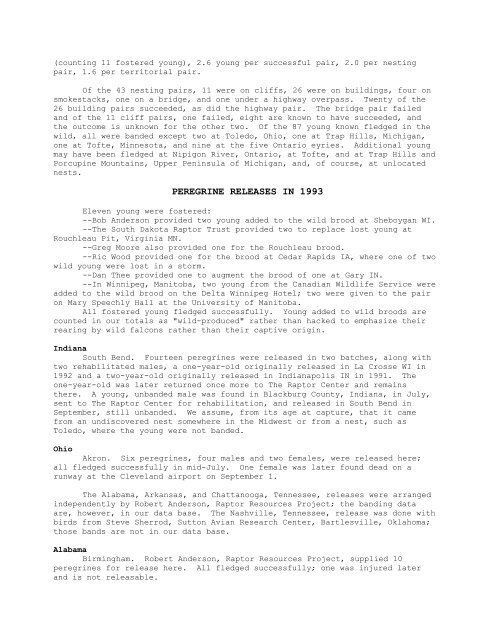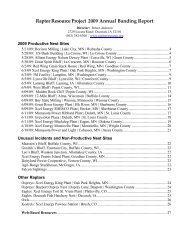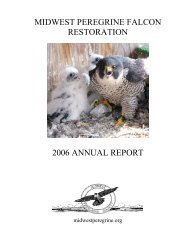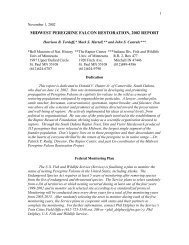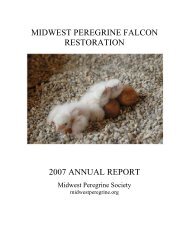1993 - Midwest Peregrine Falcon Restoration Project
1993 - Midwest Peregrine Falcon Restoration Project
1993 - Midwest Peregrine Falcon Restoration Project
You also want an ePaper? Increase the reach of your titles
YUMPU automatically turns print PDFs into web optimized ePapers that Google loves.
(counting 11 fostered young), 2.6 young per successful pair, 2.0 per nesting<br />
pair, 1.6 per territorial pair.<br />
Of the 43 nesting pairs, 11 were on cliffs, 26 were on buildings, four on<br />
smokestacks, one on a bridge, and one under a highway overpass. Twenty of the<br />
26 building pairs succeeded, as did the highway pair. The bridge pair failed<br />
and of the 11 cliff pairs, one failed, eight are known to have succeeded, and<br />
the outcome is unknown for the other two. Of the 87 young known fledged in the<br />
wild, all were banded except two at Toledo, Ohio, one at Trap Hills, Michigan,<br />
one at Tofte, Minnesota, and nine at the five Ontario eyries. Additional young<br />
may have been fledged at Nipigon River, Ontario, at Tofte, and at Trap Hills and<br />
Porcupine Mountains, Upper Peninsula of Michigan, and, of course, at unlocated<br />
nests.<br />
PEREGRINE RELEASES IN <strong>1993</strong><br />
Eleven young were fostered:<br />
--Bob Anderson provided two young added to the wild brood at Sheboygan WI.<br />
--The South Dakota Raptor Trust provided two to replace lost young at<br />
Rouchleau Pit, Virginia MN.<br />
--Greg Moore also provided one for the Rouchleau brood.<br />
--Ric Wood provided one for the brood at Cedar Rapids IA, where one of two<br />
wild young were lost in a storm.<br />
--Dan Thee provided one to augment the brood of one at Gary IN.<br />
--In Winnipeg, Manitoba, two young from the Canadian Wildlife Service were<br />
added to the wild brood on the Delta Winnipeg Hotel; two were given to the pair<br />
on Mary Speechly Hall at the University of Manitoba.<br />
All fostered young fledged successfully. Young added to wild broods are<br />
counted in our totals as "wild-produced" rather than hacked to emphasize their<br />
rearing by wild falcons rather than their captive origin.<br />
Indiana<br />
South Bend. Fourteen peregrines were released in two batches, along with<br />
two rehabilitated males, a one-year-old originally released in La Crosse WI in<br />
1992 and a two-year-old originally released in Indianapolis IN in 1991. The<br />
one-year-old was later returned once more to The Raptor Center and remains<br />
there. A young, unbanded male was found in Blackburg County, Indiana, in July,<br />
sent to The Raptor Center for rehabilitation, and released in South Bend in<br />
September, still unbanded. We assume, from its age at capture, that it came<br />
from an undiscovered nest somewhere in the <strong>Midwest</strong> or from a nest, such as<br />
Toledo, where the young were not banded.<br />
Ohio<br />
Akron. Six peregrines, four males and two females, were released here;<br />
all fledged successfully in mid-July. One female was later found dead on a<br />
runway at the Cleveland airport on September 1.<br />
The Alabama, Arkansas, and Chattanooga, Tennessee, releases were arranged<br />
independently by Robert Anderson, Raptor Resources <strong>Project</strong>; the banding data<br />
are, however, in our data base. The Nashville, Tennessee, release was done with<br />
birds from Steve Sherrod, Sutton Avian Research Center, Bartlesville, Oklahoma;<br />
those bands are not in our data base.<br />
Alabama<br />
Birmingham. Robert Anderson, Raptor Resources <strong>Project</strong>, supplied 10<br />
peregrines for release here. All fledged successfully; one was injured later<br />
and is not releasable.


